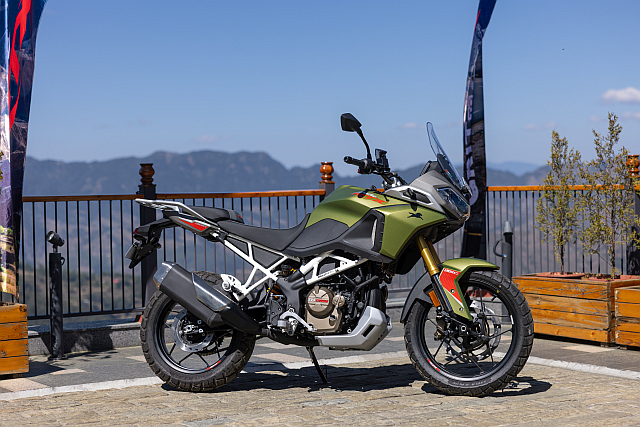
The TVS Apache RTX is, in TVS’ words, “Rally Tourer Xtreme”, the company’s first entry into the segment. Alongside its all-new RT-XD4 engine, it has been engineered against the background of the brand’s racing and rally legacy. But how does the motorcycle and its heart fare
Story: Salman Bargir
Photography: TVS Motor
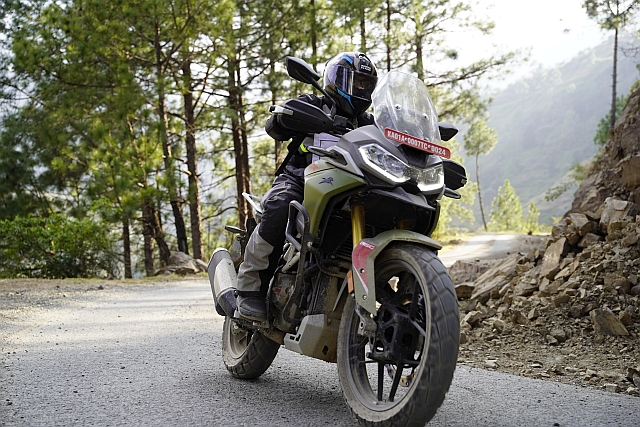
At first glance, the Apache RTX looks noticeably larger than what you’d expect from a motorcycle in its segment. A quick check confirmed this: despite being a 300-cc machine, its proportions are akin to those of a 650-cc adventure tourer. For perspective, the Kawasaki Versys 650 measures 2,165 millimetres in length, 840 mm in width, 1,360 mm in height, and has a wheelbase of 1,415 mm. In comparison, the TVS Apache RTX is larger in every dimension: 2,176 mm long, 885 mm wide, 1,400 mm tall, with a 1,430-mm wheelbase.
Naturally, its big-motorcycle proportions and appearance enhance its road presence, something most Indians are always keen on.
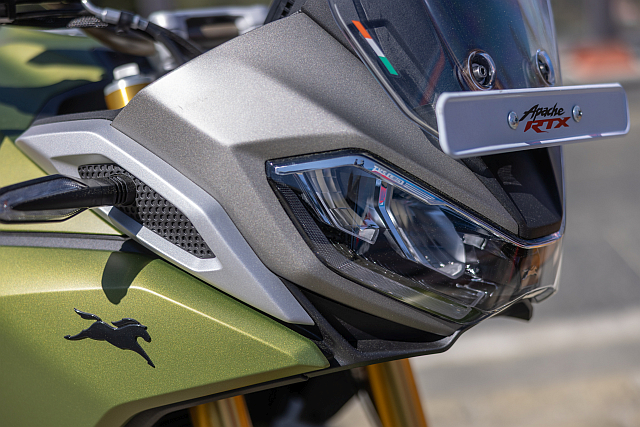
I can’t say much about the tall windscreen, because I couldn’t attain speeds high enough to test its efficacy. However, it did manage to deflect a fair bit of cold wind and dust on the mountain roads around Shimla. The same goes for the cruise control, another thoughtful addition that should prove particularly useful on long rides: the primary purpose for which the Apache RTX is built. The headlight and daytime running lights (DRL) lend it a sharp, aggressive gaze, while the tank shrouds add to its muscular stance by neatly connecting the front end with the fuel tank. The sculpted tank not only enhances its look but also facilitates a comfortable grip for the legs. Overall, the motorcycle is wide at the front and tapers towards the rear, ending in a chunky grab rail for the pillion rider. I also liked how the contrasting white frame stands out beautifully against the BTO-spec Viper Green colour of the unit I rode.

As we were about to roll from the flag-off point, I started the motorcycle and experienced the all-new engine for the first time. It feels and sounds smooth and refined, with noticeably fewer vibrations; an evident improvement on the previous Apache RR and RTR 310 units. That said, the power delivery is quite linear, which left me wanting more punch, especially for quick overtakes. There’s a bit of a learning curve to extracting the best out of it, but, in hindsight, this characteristic should make the bike more relaxed and composed at triple-digit cruising speeds, something I look forward to trying on open highways. The mountainous terrain and winding roads were not conducive to spirited riding, so some of the motorcycle’s traits remain to be fully explored. Gear shifts, particularly upshifts, are slick and supported by a light clutch action. I spent most of the ride in third gear, but when I did shift into fourth sometimes, I noticed a brief hesitation during hard acceleration, something a few other riders also experienced across gears, speeds, and ride modes. This could be a fuelling issue, possibly linked to the bi-directional quick-shifter system.
What I can say with confidence, however, is that the motorcycle’s off-road ability is truly impressive. The suspension set-up is brilliant, and kudos to TVS for that. The engine’s tractability also stands out; there’s no knocking or stalling, and the bike remains easy to balance at low speeds even on steep, off-road hairpin bends. The steel trellis frame paired with the aluminium subframe really shines here. During the few chances I had to pick up speed, the motorcycle felt remarkably stable yet agile enough to change direction quickly. This composure can be ascribed to the strategic placement of its components across the wide, well-balanced chassis.

Braking performance by both the front and rear discs is on point. The initial bite isn’t sharp but rather progressive and strong, perhaps tuned that way to prevent mishaps, especially for novice riders tackling off-road sections. The dual-purpose radial tyres offer good grip overall, though the rear felt a bit unsettled over pebbles and small rocks on tarmac and gravel, a problem that could stem from factors like tread pattern, air pressure, or temperature.
Off road, however, they performed impressively well, except through a patch of slush where the bike demanded finesse—precise throttle and steering inputs with minimal braking.

The Apache RTX can accommodate both short and tall riders. The fellow tall riders I spoke to after our ride also found the ergonomics well-suited to their build. The riding position is upright, with the rider’s footpegs placed at a neutral position. For me, the handlebar felt slightly distant, perhaps due to my short arms. What helped me, though, were the adjustable brake and clutch levers, a feature available even in the base variant. A fairly comfortable seat, placed at a slightly discomforting height, rarely bothered me after a time, and, in fact, was useful to give me a good view of the road ahead. Despite tipping the scales at 180 kilograms, the weight didn’t feel bothersome despite my relatively modest stature of five feet and five inches.
Over a 111 kilometre loop that started and ended at Theog, passing through Kufri, Fagu, Shimla, Mashobra, Baldeyan, Kolth, and Sandhu, the Apache RTX felt increasingly manageable and confidence-inspiring as the ride progressed. The route offered a mix of tarmac, gravel, rocks, pebbles, potholes, and even slush—yet the motorcycle handled it all with composure. While standing on the footpegs certainly helps on rough patches, the setup is forgiving enough to let you stay seated without your body absorbing too many shocks from the uneven terrain.
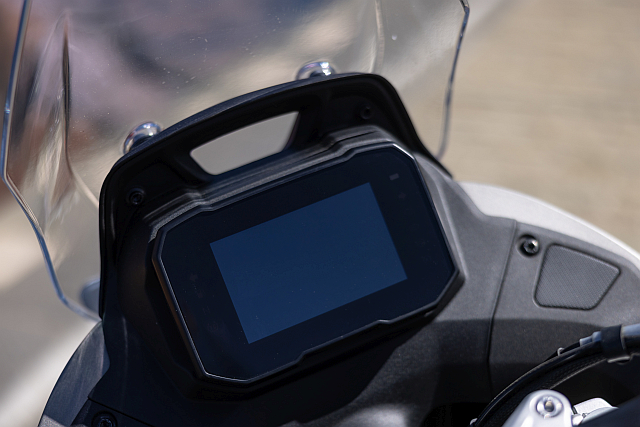
Coming to the map-mirroring function, our motorcycles were equipped with a paired smartphone, allowing us to experience it firsthand during the ride. The turn-by-turn navigation layout is neatly integrated into the crisp five-inch TFT instrument cluster, making it easy to follow directions on the go. It’s a feature I’d like to explore further, especially alongside the GoPro camera control function when we get to ride the motorcycle again.
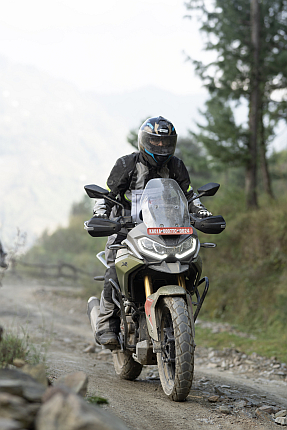
With the TVS Apache RTX, form and function truly go hand in hand. There are a few rough edges, but given TVS’s steady progress over the years, there’s both scope for and promise of improvement. The motorcycle makes a strong proposition for beginners looking to step into the world of ADVs. It’s a well-rounded machine, thoughtfully equipped in both its mechanicals and features. And with TVS announcing an off-road riding academy, a great initiative, the RTX is poised to attract plenty of eager new riders.
As the sun dipped below the Himalayas, my time with the motorcycle drew to a close. The bright red glow of the setting sun, diffused gently through the fog, offered a stunning view 2,450 metres above sea level. The automatic headlights came on as I entered the twisties ahead of the final climb of my ride, and their beam offered ample illumination and a well-spread throw. The completeness of the motorcycle, however, is expected to become more evident when we ride it back home in Pune.
Also Read: TVS Apache RTX Launched in India at an Introductory Price of Rs 1.99 Ex-showroom


Leave a Reply